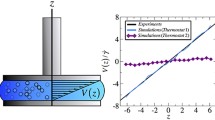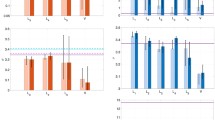Abstract
Although simulation boxes used in molecular dynamics are normally chosen to be cubic or rectangular, two other cell shapes that are very familiar to crystallographers—the truncated octahedron and the rhombic dodecahedron—could also be used because they are also space-filling cells. Due to their spherical nature, these boxes have been intentionally applied in simulations of biomolecular solutions and liquid structures. Indeed, due to the advantages of running many molecular dynamic codes in parallel, simulations based on these non-rectangular boxes have been growing in popularity in recent years. In this work, the effects of using these two types of boxes on diffusion are explored for the first time, and an appropriate correction formula is derived theoretically within the framework of hydrodynamics. In addition, the range of validity for the correction formula is evaluated by performing molecular dynamic simulations on argon at three different densities.





Similar content being viewed by others
References
Allen MP, Tildesley DJ (1989) Computer simulation of liquids. Clarendon, Oxford, p 26
van der Spoel D, Lindahl E, Hess B, van Buuren AR, Apol E, Meulenhoff PJ, Tieleman DP, Sijbers ALTM, Feenstra KA, van Drunen R, Berendsen HJC (2010) Gromacs user manual, version 4.5.6, p 13. www.gromacs.org
Papavasileiou KD, Avramopoulos GL, Papadopoulos MG (2017) Computational investigation of fullerene–DNA interactions: implications of fullerene’s size and functionalization on DNA structure and binding energetics. J Mol Graph Model 74:177–192
Xun SN, Jiang F, Wu YD (2016) Intrinsically disordered regions stabilize the helical form of the C-terminal domain of RfaH: a molecular dynamics study. Bioorg Med Chem 24:4970–4977
Maganti L, Grandhb P, Ghoshal N (2016) Integration of ligand and structure based approaches for identification of novel MbtI inhibitors in Mycobacterium tuberculosis and molecular dynamics simulation studies. J Mol Graph Model 70:14–22
Tarus B, Nguyen PH, Berthoumieu O, Faller P, Doig AJ, Derreumaux P (2015) Molecular structure of the NQTrp inhibitor with the Alzheimer Ab1-28 monomer. Eur J Med Chem 91:43–50
Zhou M, Du K, Ji PJ, Feng W (2012) Molecular mechanism of the interactions between inhibitory tripeptides and angiotensin-converting enzyme. Biophys Chem 168:60–66
Han S (2008) Force field parameters for S-nitrosocysteine and molecular dynamics simulations of S-nitrosated thioredoxin. Biochem Biophys Res Commun 377:612–616
Farhi A, Singh B (2017) A novel method for calculating relative free energy of similar molecules in two environments. Comput Phys Commun 212:132–145
Hirano A, Maruyama T, Shiraki K, Arakawa T, Kameda T (2017) A study of the small-molecule system used to investigate the effect of arginine on antibody elution in hydrophobic charge-induction chromatography. Protein Expr Purif 129:44–52
Rogers DM (2016) Overcoming the minimum image constraint using the closest point search. J Mol Graph Model 68:197–205
Ghadari R, Alavi FS, Zahedi M (2015) Evaluation of the effect of the chiral centers of Taxol on binding to β-tubulin: a docking and molecular dynamics simulation study. Comput Biol Chem 56:33–40
Tekin ED (2014) Odd–even effect in the potential energy of the self-assembled peptide amphiphiles. Chem Phys Lett 614:204–206
Gupta M, Chauhan R, Prasad Y, Wadhwa G, Jain CK (2016) Protein–protein interaction and molecular dynamics analysis for identification of novel inhibitors in Burkholderia cepacia GG4. Comput Biol Chem 65:80–90
Ngo ST, Truong DT, Tam NM, Nguyen MT (2017) EGCG inhibits the oligomerization of amyloid beta (16-22) hexamer: theoretical studies. J Mol Graph Model 76:1–10
Luo MH, Wang H, Zou Y, Zhang SP, Xiao JH, Jiang GD, Zhang YH, Lai YS (2016) Identification of phenoxyacetamide derivatives as novel dot1L inhibitors via docking screening and molecular dynamics. Simulation 68:128–139
Hess B, Van der Spoel D, Lindahl E (2008) GROMACS 4: algorithms for highly efficient, load-balanced, and scalable molecular simulation. J Chem Theory Comput 4:435–447
Plimpton S (1995) Fast parallel algorithms for short-range molecular dynamics. J Comput Phys 117:1–19 http://lammps.sandia.gov
Kale L, Skeel R, Bhandarkar M, Brunner R, Gursoy A, Krawetz N et al (1999) NAMD2: greater scalability for parallel molecular dynamics. J Comput Phys 151:283–312 http://www.ks.uiuc.edu/Research/namd/
Mackerell AD, Bashford D, Bellott M, Dunbrack RL, Evanseck JD et al (1998) All-atom empirical potential for molecular modeling and dynamics studies of proteins. J Phys Chem B 102:3586–3616 https://www.charmm.org/
Dünweg B, Kremer K (1993) Molecular dynamics simulation of a polymer chain in solution. J Chem Phys 99:6983–6997
Yeh IC, Hummer G (2004) System-size dependence of diffusion coefficients and viscosities from molecular dynamics simulations with periodic boundary conditions. J Phys Chem B 108:15873–15879
Yang XF, Zhang H, Li L, Ji XF (2017) Corrections of the periodic boundary conditions with rectangular simulation boxes on the diffusion coefficient, general aspects. Mol Simul 43:1423–1429
Kikugawa G, Ando S, Suzuki J, Naruke Y, Nakano T, Ohara T (2015) Effect of the computational domain size and shape on the self-diffusion coefficient in a Lennard-Jones liquid. J Chem Phys 142:024503
Kikugawa G, Nakano T, Ohara T (2015) Hydrodynamic consideration of the finite size effect on the self-diffusion coefficient in a periodic rectangular parallelepiped system. J Chem Phys 143:0245071–0245078
Moultos OA, Zhang Y, Tsimpanogiannis IN, Economou IG, Maginn E (2016) System-size correction for self-diffusion coefficients calculated from molecular dynamics simulations: the case of CO2, n-alkanes, and poly(ethylene glycol) dimethyl ethers. J Chem Phys 145:074109
Simonnin P, Noetinger B, Nieto-Draghi C, Marry V, Rotenberg B (2017) Diffusion under confinement: hydrodynamic finite-size effect in simulation. J Chem Theory Comput 13:2881–2889
Jamali SH, Wolff L, Becker TM, Bardow A, Vlugt TJH, Moultos OA (2018) Finite-size effect of binary mutual diffusion coefficients from molecular dynamics. J Chem Theory Comput 14:2667–2677
Stearn AE, Irish EM, Eyring H (1940) A theory of diffusion in liquids. J Phys Chem 44:981–995
Mccall DW, Douglass DC (1967) Diffusion in binary solutions. J Phys Chem 71:987–997
Hasimoto H (1959) On the periodic fundamental solutions of the Stokes equations and their application to viscous flow past a cubic array of spheres. J Fluid Mech 5:317–328
Nijboer BRA, De Wette FW (1957) On the calculation of lattice sums. Physica 23:309–321
Yamakawa H (1970) Transport properties of polymer chains in dilute solution: hydrodynamic interaction. J Chem Phys 53:436–443
Lide DR (2005) CRC handbook of chemistry and physics, 86th edn. CRC, Boca Raton, p 1209
Author information
Authors and Affiliations
Corresponding author
Additional information
Publisher’s Note
Springer Nature remains neutral with regard to jurisdictional claims in published maps and institutional affiliations.
Appendices
Appendix 1: Proof that a diagonal second-rank tensor with the same diagonal elements is invariant under coordinate rotations. i.e., \( {T}_{ij}^{\prime }={T}_{ij} \)
Rotation of coordinate axes and orthogonal matrices
We consider two coordinate systems K and K′ with a common origin. Any vector X can be expressed as (x1, x2, x3) in the unprimed system or \( \left({x}_1^{\prime },{x}_2^{\prime },{x}_3^{\prime}\right) \) in the primed system (see Fig. 6). \( \mathbf{X}={\sum}_{\mathrm{j}=1}^3{x}_j{\mathbf{e}}_j \) or, in the Einstein convention (i.e., if an index occurs twice or more in a term, it implies that the term is to be summed over all possible values of the index),
and in the K′ coordinate system,
where \( {\mathbf{e}}_j\ \mathrm{and}\ {\mathbf{e}}_j^{\prime } \) are the unit vectors in the jth direction in the K and K′ coordinate systems, respectively. Combining Eq. 11 and Eq. 12, we obtain
Left-dotting \( {\mathbf{e}}_i^{\prime } \) into Eq. 13, and using \( {\mathbf{e}}_i^{\prime}\bullet {\mathbf{e}}_k^{\prime }={\delta}_{ik} \),
We now define the coordinate rotation operation matrix A, whose elements are
Using this definition, we have
or, in Dirac bra-ket notation,
The vector in Eq. 16 with one column and three rows is called a column vector. Similarly, if a matrix has one row and three columns, it is called a row vector, 〈x|, with components xi, i = 1, 2, 3. Clearly, 〈x| is derived from ∣x〉 by interchanging rows and columns, a matrix operation called “transposition.” The transposition of any matrix A yields AT, called the transpose of A, with matrix elements (AT)ij = Aji. Writing Eq. 16 in row vector form,
Matrix A represents an operation that transforms the components of X in the unprimed system to the components in the primed system. By the same argument, if there is an operation matrix A−1 that inversely transforms the components of X in the primed system to those in the unprimed system,
or
That is, A−1 produces the opposite rotation to that given by A, meaning that it returns the coordinate system to its original position. Equations 16 and 19 combine to give
Since ∣x〉 is chosen arbitrarily,
the unit matrix. Similarly, using Eqs. 16 and 19 and eliminating ∣x〉 instead of ∣x′〉,
From Eqs. 21 and 22, A commutes with A−1.
The rotation given by A keeps the length from the origin to the point the same in both systems. Squaring for convenience gives
Since vector ∣x〉 is arbitrary,
Multiplying Eq. 24 by A−1 from the right and using Eq. 22, we have
another definition of an orthogonal matrix. Multiplying Eq. 25 by A, we obtain
or
Diagonal tensor and its transformation under coordinate rotations
In physics, the mobility tensor Tij is defined as the ith component of the drift velocity of an object under the influence of unit external force in the jth direction,
if the system is symmetric about the three principal axes in the K coordinate system (j = 1, 2, 3). Tij must be a diagonal tensor with the same values as Tjj. Its components in the K′ coordinate system, \( {T}_{ij}^{\prime }, \) conform to the transformation
Because Tkl = 0 for k ≠ l and Tkl = T11 for k = l, any diagonal elements must be equal to T11. Taking i = j = 2 for example, we expand Eq. 29 as
From Eq. 27, j = k = 2 and a2ia2i = δ22 = 1, so we have
Similarly, for the off-diagonal elements \( {T}_{ij}^{\prime }, \)
Thus,\( {T}_{ij}^{\prime } \) has the same form as Tij.
Appendix 2: Equivalence of the descriptions of motion in three different primitive cells in molecular dynamics
Let us consider the three different primitive cells for the lattice shown in Fig. 7. The first type of cell, a parallelogram formed by two translational vectors a1 and a2, is primitive because there is only one lattice point in each cell (Fig. 7a). The rectangles in Fig. 7b are another form of primitive cell. One edge of the rectangular cell overlaps with the edge of the parallelogram, while another edge is just the projection of the parallelogram on the y-axis. If we suppose that all the lattice points lie at the geometrical centers of the parallelograms, then the area enclosed by the perpendicular bisectors of the lines joining the nearest lattice points is the Wigner–Seitz cell (Fig. 7c).
It is easy to prove that the areas of the three cells are the same. If N molecules are placed in the parallelogram and periodic boundary conditions are applied (only the ith and the jth molecules are shown in Fig. 7a), each molecule will appear exactly once in both the rectangular cell (Fig. 7b) and the Wigner–Seitz cell (Fig. 7c). Of course, some molecules that appear in the rectangular cell (or the Wigner–Seitz cell) are just image molecules in the parallelogram. Whether the molecule or its image is included makes no difference because the two possess exactly the same physical quantities (mass, velocity, spatial orientation, etc.). For a given molecule, e.g., the jth one, the other molecules around it are exactly the same in all three cases, so the forces exerted on the jth molecule are identical, which in turn gives rise to the same trajectory of motion in each case. In fact, if the boundaries of the cells are removed, the spatial locations of all the molecules are exactly the same. This best illustrates the equivalence of the descriptions of motion in the three cell types.
Rights and permissions
About this article
Cite this article
Cao, T., Ji, X., Wu, J. et al. Correction of diffusion calculations when using two types of non-rectangular simulation boxes in molecular simulations. J Mol Model 25, 22 (2019). https://doi.org/10.1007/s00894-018-3910-6
Received:
Accepted:
Published:
DOI: https://doi.org/10.1007/s00894-018-3910-6






